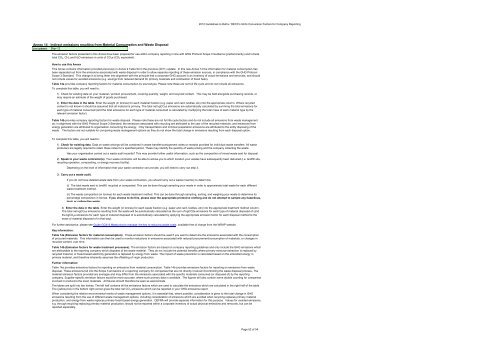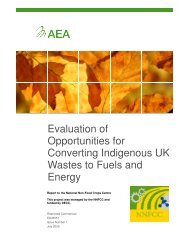Greenhouse gas conversion factors for company reporting
Greenhouse gas conversion factors for company reporting
Greenhouse gas conversion factors for company reporting
Create successful ePaper yourself
Turn your PDF publications into a flip-book with our unique Google optimized e-Paper software.
2012 Guidelines to Defra / DECC's GHG Conversion Factors <strong>for</strong> Company Reporting<br />
Annex 14 - Indirect emissions resulting from Material Consumption and Waste Disposal<br />
Last updated: Apr-12<br />
The emission <strong>factors</strong> presented in this Annex have been prepared <strong>for</strong> use within <strong>company</strong> <strong>reporting</strong> in line with GHG Protocol Scope 3 Guidance (predominantly) and include<br />
total CO 2, CH 4 and N 2O emissions in units of CO 2e (CO 2 equivalent).<br />
How to use this Annex<br />
This Annex contains in<strong>for</strong>mation provided previously in Annex 9 Table 9d in the previous (2011) update. In this new Annex 14 the in<strong>for</strong>mation <strong>for</strong> material consumption has<br />
been separated out from the emissions associated with waste disposal in order to allow separate <strong>reporting</strong> of these emission sources, in compliance with the GHG Protocol<br />
Scope 3 Standard. This change is to bring them into alignment with the principle that a corporate GHG account is an inventory of actual emissions and removals, and should<br />
not include values <strong>for</strong> avoided emissions (e.g. savings from reduced demand <strong>for</strong> primary materials and combustion of fossil fuels).<br />
Table 14a provides <strong>company</strong> <strong>reporting</strong> <strong>factors</strong> <strong>for</strong> material consumption by source/type. Please note these are not full life cycle and do not include all emissions.<br />
To complete this table, you will need to:<br />
1) Check <strong>for</strong> existing data on your material / product procurement, covering quantity, weight, and recycled content. This may be held alongside purchasing records, or<br />
may require an estimate of the weight of goods purchased.<br />
2) Enter the data in the table. Enter the weight (in tonnes) <strong>for</strong> each material fraction (e.g. paper and card, textiles, etc) into the appropriate column. Where recycled<br />
content is not known it should be assumed that all material is primary. The total net kgCO 2e emissions are automatically calculated by summing the total emissions <strong>for</strong><br />
each type of material consumed (and the total emissions <strong>for</strong> each type of material consumed is calculated by multiplying the total mass of each material type by the<br />
relevant emission factor).<br />
Table 14b provides <strong>company</strong> <strong>reporting</strong> <strong>factors</strong> <strong>for</strong> waste disposal. Please note these are not full life cycle <strong>factors</strong> and do not include all emissions from waste management<br />
as, in alignment with the GHG Protocol Scope 3 Standard, the emissions associated with recycling are attributed to the user of the recycled materials, and emissions from<br />
energy generation are attributed to organisation consuming the energy. Only transportation and minimal preparation emissions are attributed to the entity disposing of the<br />
waste. The <strong>factors</strong> are not suitable <strong>for</strong> comparing waste management options as they do not show the total change in emissions resulting from each disposal option.<br />
To complete this table, you will need to:<br />
1) Check <strong>for</strong> existing data. Data on waste arisings will be contained in waste transfer/consignment notes or receipts provided <strong>for</strong> individual waste transfers. All waste<br />
producers are legally required to retain these notes <strong>for</strong> a specified period. These may identify the quantity of waste arising and the <strong>company</strong> collecting the waste.<br />
3) Carry out a waste audit.<br />
For further assistance, please see Guide GG414 Measuring to manage: the key to reducing waste costs, available free of charge from the WRAP website.<br />
Key in<strong>for</strong>mation:<br />
Table 14a (Emission <strong>factors</strong> <strong>for</strong> material consumption): These emission <strong>factors</strong> should be used if you want to determine the emissions associated with the consumption<br />
of procured materials. This in<strong>for</strong>mation can then be used to monitor reductions in emissions associated with reduced procurement/consumption of materials, or changes in<br />
recycled content, over time.<br />
Table 14b (Emission <strong>factors</strong> <strong>for</strong> waste treatment processes): The emission <strong>factors</strong> are based on <strong>company</strong> <strong>reporting</strong> guidelines and only include the GHG emissions which<br />
are attributable to the <strong>reporting</strong> <strong>company</strong> which disposes of the waste material. They do not include the potential benefits where primary resource extraction is replaced by<br />
recycled material, or fossil-based electricity generation is replaced by energy from waste. The impact of waste prevention is calculated based on the embodied energy in<br />
primary material, and there<strong>for</strong>e inherently assumes the offsetting of virgin production.<br />
Further in<strong>for</strong>mation:<br />
Has your organisation carried out a waste audit recently? This may provide further useful in<strong>for</strong>mation, such as the composition of mixed waste sent <strong>for</strong> disposal.<br />
2) Speak to your waste contractor(s). Your waste contractor will be able to advise you to which location your wastes have subsequently been delivered (i.e. landfill site,<br />
recycling operation, compositing, or energy recovery facility).<br />
Depending on the level of in<strong>for</strong>mation that your waste contractor can provide, you will need to carry out step 3.<br />
If you do not have detailed waste data from your waste contractors, you should carry out a waste inventory to determine:<br />
(i) The total waste sent to landfill, recycled or composted. This can be done through sampling your waste in order to approximate total waste <strong>for</strong> each different<br />
waste treatment method.<br />
(ii) The waste composition (in tonnes) <strong>for</strong> each waste treatment method. This can be done through sampling, sorting, and weighing your waste to determine its<br />
percentage composition in tonnes. If you choose to do this, please wear the appropriate protective clothing and do not attempt to sample any hazardous,<br />
toxic or radioactive waste.<br />
4) Enter the data in the table. Enter the weight (in tonnes) <strong>for</strong> each waste fraction (e.g. paper and card, textiles, etc) into the appropriate treatment method column.<br />
The total net kgCO 2e emissions resulting from the waste will be automatically calculated as the sum of kgCO2e emissions <strong>for</strong> each type of material disposed of (and<br />
the kgCO 2e emissions <strong>for</strong> each type of material disposed of is automatically calculated by applying the appropriate emission factor <strong>for</strong> each disposal method to the<br />
mass of material disposed of in that way).<br />
Table 14a provides emissions <strong>factors</strong> <strong>for</strong> <strong>reporting</strong> on emissions from material consumption. Table 14b provides emissions <strong>factors</strong> <strong>for</strong> <strong>reporting</strong> on emissions from waste<br />
disposal. These emissions fall into the Scope 3 emissions of a <strong>reporting</strong> <strong>company</strong> <strong>for</strong> companies that are not directly involved in/controlling the waste disposal process. The<br />
material emission <strong>factors</strong> provided are averages and may differ from the emissions associated with the specific materials consumed (or disposed of) by the <strong>reporting</strong><br />
<strong>company</strong>. Supplier-specific emission <strong>factors</strong> would be more accurate, where such primary data is available. The figures will also contain some double counting <strong>for</strong> companies<br />
involved in producing the given materials. All figures should there<strong>for</strong>e be seen as approximate.<br />
The tables are split into two halves. The left half contains all the emissions <strong>factors</strong> which are used to calculate the emissions which are calculated in the right half of the table.<br />
The (yellow) box in the bottom right corner gives the total net CO 2 emissions which can be reported in your GHG emissions report.<br />
When considering the relative environmental merits of waste management options, it is essential that, where possible, consideration is given to the total change in GHG<br />
emissions resulting from the use of different waste management options, including consideration of emissions which are avoided when recycling replaces primary material<br />
production, and energy from waste replaces primary fossil-based energy generation. DEFRA will provide separate in<strong>for</strong>mation <strong>for</strong> this purpose. Values <strong>for</strong> avoided emissions,<br />
e.g. through recycling replacing primary material production, should not be reported within a corporate inventory of actual physical emissions and removals, but can be<br />
reported separately.<br />
Page 52 of 54








